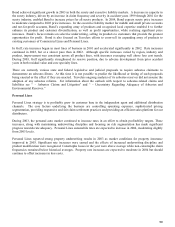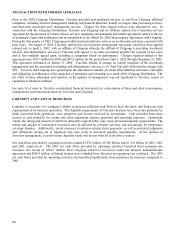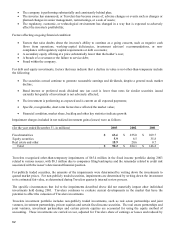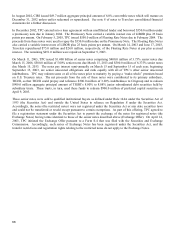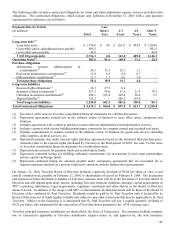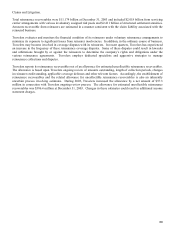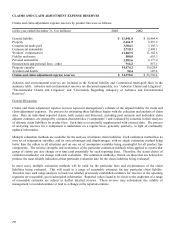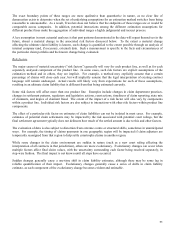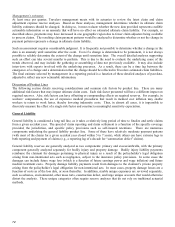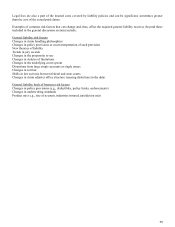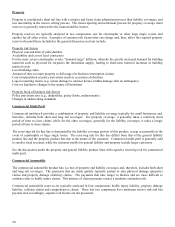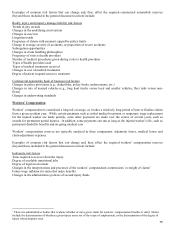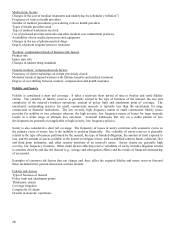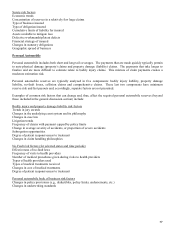Travelers 2003 Annual Report Download - page 70
Download and view the complete annual report
Please find page 70 of the 2003 Travelers annual report below. You can navigate through the pages in the report by either clicking on the pages listed below, or by using the keyword search tool below to find specific information within the annual report.68
commissioner for the declaration or payment of any dividend that together with other distributions made within the
preceding twelve months exceeds the greater of 10% of the insurer's surplus as of the preceding December 31, or the
insurer's net income for the twelve-month period ended the preceding December 31, in each case determined in
accordance with statutory accounting practices. This declaration or payment is further limited by adjusted unassigned
surplus, as determined in accordance with statutory accounting practices. The insurance holding company laws of
other states in which Travelers subsidiaries are domiciled generally contain similar, although in some instances
somewhat more restrictive, limitations on the payment of dividends. A maximum of $1.647 billion is available by the
end of 2004 for such dividends without prior approval of the Connecticut Insurance Department.
On September 25, 2002, the Board of Directors approved a $500.0 million share repurchase program. Purchases of class A
and class B stock may be made from time to time in the open market, and it is expected that funding for the program will
principally come from dividends from TPC’s operating subsidiaries. Shares repurchased are reported as treasury stock in
the consolidated balance sheet. During 2003, TPC repurchased approximately 2.6 million shares of class A common stock
at a total cost of $40.0 million, representing the first acquisition of shares under this program. Also during 2003, 1.8
million shares of common stock were acquired from employees as treasury stock primarily to cover payroll withholding
taxes in connection with the vesting of restricted stock awards and exercises of stock options. In anticipation of the
potential merger with SPC, Travelers does not anticipate the repurchase of additional shares in 2004.
TPC has the option to defer interest payments on its convertible junior subordinated notes for a period not exceeding
20 consecutive quarterly interest periods. If TPC elects to defer interest payments on the notes, it will not be
permitted, with limited exceptions, to pay dividends on its common stock during a deferral period.
The NAIC adopted RBC requirements for property casualty companies to be used as minimum capital requirements by
the NAIC and states to identify companies that merit further regulatory action. The formulas have not been designed
to differentiate among adequately capitalized companies that operate with levels of capital higher than RBC
requirements. Therefore, it is inappropriate and ineffective to use the formulas to rate or to rank these companies. At
December 31, 2003, all of Travelers insurance subsidiaries had adjusted capital in excess of amounts requiring any
company or regulatory action.
CRITICAL ACCOUNTING ESTIMATES
Travelers considers its most significant accounting estimates to be those applied to claim and claim adjustment
expense reserves and related reinsurance recoverables.
Total claims and claim adjustment expense reserves were $34.573 billion at December 31, 2003. Travelers maintains
property and casualty loss reserves to cover estimated ultimate unpaid liability for losses and loss adjustment expenses
with respect to reported and unreported claims incurred as of the end of each accounting period. Reserves do not
represent an exact calculation of liability, but instead represent estimates, generally utilizing actuarial projection
techniques at a given accounting date. These reserve estimates are expectations of what the ultimate settlement and
administration of claims will cost based on Travelers assessment of facts and circumstances then known, review of
historical settlement patterns, estimates of trends in claims severity, frequency, legal theories of liability and other
factors. Variables in the reserve estimation process can be affected by both internal and external events, such as
changes in claims handling procedures, economic inflation, legal trends and legislative changes. Many of these items
are not directly quantifiable, particularly on a prospective basis. Additionally, there may be significant reporting lags
between the occurrence of the policyholder event and the time it is actually reported to the insurer. Reserve estimates
are continually refined in a regular ongoing process as historical loss experience develops and additional claims are
reported and settled. Adjustments to reserves are reflected in the results of the periods in which the estimates are
changed. Because establishment of reserves is an inherently uncertain process involving estimates, currently
established reserves may not be sufficient. If estimated reserves are insufficient, Travelers will incur additional
income statement charges.
Some of Travelers loss reserves are for asbestos and environmental claims and related litigation which aggregated
$3.267 billion at December 31, 2003. While the ongoing study of asbestos claims and associated liabilities and of
environmental claims considers the inconsistencies of court decisions as to coverage, plaintiffs’ expanded theories of
liability, and the risks inherent in major litigation and other uncertainties, in the opinion of Travelers management, it is
possible that the outcome of the continued uncertainties regarding asbestos-related claims could result in liability in
future periods that differ from current reserves by an amount that could be material to Travelers future operating
results and financial condition. See the preceding discussion of Asbestos Claims and Litigation and Environmental



